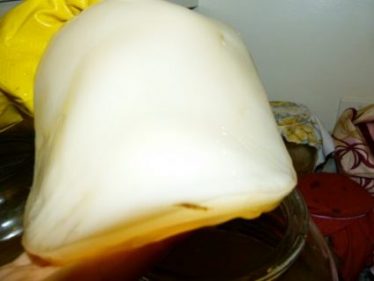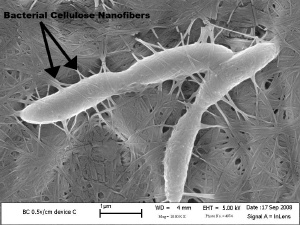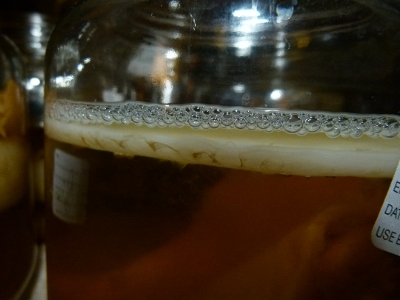Kombucha SCOBY Explained and Top 5 Other Uses for a SCOBY
A Kombucha SCOBY may seem strange at first. But along with strong starter liquid, a healthy SCOBY is the key to a successful brew and a lifetime supply of Kombucha.

Big Baby Kombucha SCOBY!
Learn more with a quick Kombucha SCOBY FAQ.
Then once you have a SCOBY Hotel full of cultures, check out other uses for a Kombucha SCOBY below.
Kombucha SCOBY Fears
As with many things Kombucha related, the Kombucha SCOBY is often misunderstood. Although highly functional and completely natural, the “strange” appearance and texture of a SCOBY leads to fear or confusion for new home brewers. To make matters worse, many well-meaning but poorly researched blog posts and articles spread confusion, including by “major media” outlets. Even supposedly reputable Kombucha SCOBY sellers spread false information (aka lies) to trick newbies into buying dehydrated or poor quality products.
Never fear! It is possible to source a high quality Kombucha SCOBY. And a healthy SCOBY is very hardy and can easily be cared for correctly.
Kombucha SCOBY Questions
Where does SCOBY come from?
SCOBY is an acronym for Symbiotic Culture of Bacteria and Yeast. Click to learn who invented the term SCOBY and why. It is also known as a biofilm, pellicle, zooglea (living skin), yeast mat or near lichen.
What is SCOBY made of?
Kombucha SCOBY is the product of the bacteria in the brew, which create strands of cellulose that weave together. This mat of bacterial cellulose is safe for all living things and even edible. It acts kind of like an apartment building; the yeast live on one floor, bacteria on the next, and so on.

Kombucha SCOBY under a microscope reveals nanostructures that can help human skin to rebuild.
Do I have a healthy SCOBY?
A Kombucha SCOBY can look smooth and “pretty” or bumpy and “ugly” but as long as it makes delicious Kombucha, it’s healthy. Brewing a batch along with strong Kombucha starter liquid is the best way to tell if the SCOBY is good or it a replacement is needed. For pictures of many different SCOBYs, check out the Kombucha SCOBY NOT MOLD Galleries on this page.
Kombucha SCOBY Sources
How Can I Find a Kombucha SCOBY Near Me?
Getting a SCOBY from a friend is a great way to start. Just be sure they include a large SCOBY that has never been refrigerated, plenty of strong starter liquid, and clear instructions. If no friends are brewing, there may be a free exchange or message board in your area, but watch out for vinegar eels and old cultures. Or to avoid the hassle, and for the best Kombucha SCOBY delivered free to your door in 2 days, consider ordering a Kombucha Kamp SCOBY.
How much SCOBY do I need for Kombucha?
KKamp recommends 1 large Kombucha SCOBY plus 1-2 cups of strong Kombucha starter liquid per gallon of sweet tea. A large SCOBY is 5-6 inches across and ½ to 1 inch thick on average. Every KKamp Kombucha SCOBY for sale meets this size or larger and comes packed in strong starter liquid to make a gallon of Kombucha in the first batch.
Kombucha SCOBY Recipe and Brewing
What’s the best Kombucha SCOBY recipe?
Check out our Kombucha Recipe here and even download the free DIY Guide.
My Kombucha SCOBY sinks in the brew, what’s wrong?
Nothing! The original SCOBY may sink or float and may end up anywhere in the brew, even the bottom of the Kombucha brewing vessel. The new Kombucha SCOBY will form across the top of the brew.
Is there Kombucha SCOBY mold on my culture?
Unless it’s dry and fuzzy, whatever is on your Kombucha SCOBY is probably not mold. To find out more, visit this Kombucha SCOBY Mold Gallery.
Kombucha SCOBY Care
Is it okay to divide SCOBY?
Yes you may cut Kombucha SCOBY any way you like using clean knives or scissors. Don’t worry, you cannot cause any pain or damage to the cellulose of the SCOBY or the bacteria and yeast. 🙂
I heard Kombucha and metal don’t mix?
Stainless steel 304 grade or higher is perfectly safe with Kombucha. Using any stainless steel utensils is also safe. And it is true that brewing in metal containers that are not stainless steel (brass, copper, etc) is unsafe with Kombucha. However, briefly cutting a Kombucha SCOBY with metal scissors or knives, even if not made of stainless steel, is not a problem due to the very short exposure.
Which SCOBY do I keep, the new one or the original mother?
Either or both, there is no right or wrong answer. The new Kombucha SCOBY layer may be whiter and smoother due to resting on top of the brew and less exposure to tea and yeast, which cause the browner color. But as long as both cultures are healthy, stock up the SCOBY Hotel until it’s full.
Kombucha SCOBY Storage
Can I Put my SCOBY in the Fridge?
Never refrigerate a Kombucha SCOBY! And avoid sites that recommend refrigeration of the SCOBY or SCOBY Hotel.
How do you store a SCOBY?
Store your Kombucha SCOBY at room temperature in a SCOBY Hotel (Video).
What kind of SCOBY maintenance is required?
Trimming away extra Kombucha SCOBY growth and refreshing the SCOBY Hotel is recommended. Find out more about SCOBY Hotel Maintenance here.
Why Do I Need More Than 1 SCOBY?
It is possible to literally make a LIFETIME supply starting with just one SCOBY! You must be patient, and care for the Kombucha SCOBY and it’s babies properly. But if done well, the single Kombucha SCOBY and its offspring could become many Hotels and multiple brews all going at once.

The birth of a Kombucha SCOBY!
Some people prefer to get multiple gallons brewing right away and need a couple of SCOBYs or more. Especially if you want to try Continuous Brew Kombucha or just get a bunch of jars going immediately, multiple SCOBYs cuts the waiting time, which is the hardest part about brewing. KKamp’s Kombucha Recipe calls for 1 large SCOBY and 1-2 cups of strong starter liquid per gallon of sweet tea for best results.
Should I Keep Every SCOBY I Have?
One of Kombucha’s greatest gifts is that it reproduces infinitely in the form of a new Kombucha SCOBY with each brew if it is properly cared for. At first, this is a miraculous delight for the homebrewer, but after a few cycles, it can seem like you are in trouble with Tribbles. Many people are loath to simply toss the extra cultures.
The great news is that this is a win-win situation. Science has barely begun to grasp the full scope of Kombucha’s usefulness from functional beverage, to household cleaner, to skin & hair care product to vegan leather substitute. This flexibility gives the home brewer an excellent opportunity to experiment. Instead of dreading what to do with those extra cultures, check out some great tips for other ways to use them.
WHAT TO DO WITH AN EXTRA KOMBUCHA SCOBY
And now for the fun stuff! Look at all these exciting ways you can use a Kombucha SCOBY around the house or even right on your face!
Beauty is Skin Deep
- Check out these Kombucha Spa Day recipes for making your very own beauty masque and toner and other homemade products for your skin.
- Take a fresh Kombucha SCOBY and lay it across your face (no, it will not suck your brains out!). Allow the culture to rest on your face for up to 15 minutes, using a towel to catch the drips. You may notice some redness on your skin but it will quickly fade. If you are sensitive, always test first on a small section of skin.
Why this works
-
- The culture pulls circulation to the surface of the skin which regenerates the skin cells
- The pH of the culture has the effect of a mild and all natural acid peel which sloughs dead skin cells and leaves the skin feeling soft and smooth
Living Band-Aids
- The Kombucha culture also has many topical uses. One of the terms for the SCOBY is zooglea, which translates as “living skin” and helps heal the skin from burns, wounds and other skin ailments. Biofilms are not new and have a wide range of applications from medicinal bandages, replacement blood veins, speaker diaphragms and more. BASYC is one such biofilm that is being tested and manufactured for such purposes. They have isolated an acetobacter xylinium strain – one of the bacteria native to the Kombucha culture – to create this biofilm.
- You can use pieces of the culture topically to speed healing of cuts, burns and other wounds. Cut a piece to size and hold in place with a bandage wrap. It will sting a bit, much like iodine.
Why this works
-
- The pH of the culture inhibits the growth of harmful organisms.
- The bacteria send out microfibrils which are filament strands. These link up with those of other bacteria creating a nano-structure that thickens over time.
Pets are People too!
- Animals can also reap the health benefits of Kombucha. We give our dog Sydney Kombucha in her food everyday. She has a shiny coat, healthy skin and nails (despite having come to us with a bad case of mange) and very regular elimination.
Why this works
-
- All animals benefit from a healthy diet and digestive system
Vegan Sushi?
- With the oceans being poisoned by plastic, healthy fish supplies are running low. Save a fish, eat a SCOBY! While some may be put off by the rubbery texture at first, it is actually quite similar to raw squid.
- If you don’t want to eat it straight, try adding a piece to your smoothie.
Why this works
-
- Increasing the amount of cellulose in your diet can help ease elimination and improve colon health
How Does Your Garden Grow?
- Many plants thrive in more acidic soil environments. Grind up or coarsely chop a SCOBY and add it to your soil mix.
- Adding extra SCOBYs to the compost pile is a great way to return the culture to the earth. Throw them in my worm bin and boy, you will have a lot of happy worms! =) You can use the worm tea to nourish your garden.
Why this works
-
- pH is a measure of the concentration of hydrogen ions. The higher amount of hydrogen ions present, the more acid the pH. Soil acidity affects a plant’s ability to absorb necessary nutrients
Do you have a use for Kombucha SCOBY that isn’t listed here? Send us a message via the Contact Page.

